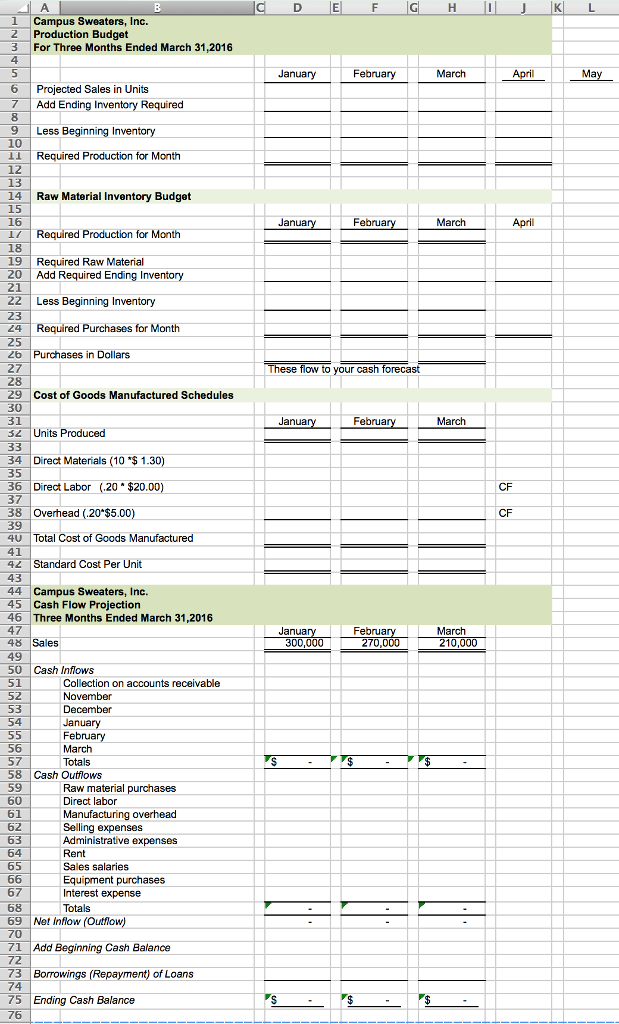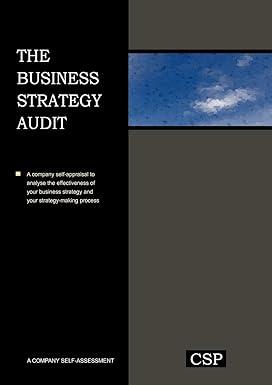Question
Use this Excel Culminating Project Template (SEE SCREENSHOT BELOW) to help you get started with your budget You are the president of Campus Sweaters, Inc.
Use this Excel Culminating Project Template (SEE SCREENSHOT BELOW) to help you get started with your budget
You are the president of Campus Sweaters, Inc. Campus Sweaters manufacturers wool pullover v-neck sweaters of various sizes and colors. You are preparing the budgets for the first quarter of 2016 (January, February, and March). You have the following historical and projected sales in units:
| Actual or Projected | Month | Units |
|---|---|---|
| Actual | November | 9,000 |
| Actual | December | 8,000 |
| Projected | January | 11,000 |
| Projected | February | 10,000 |
| Projected | March | 6,000 |
| Projected | April | 7,000 |
| Projected | May | 7,000 |
| Projected | June | 7,000 |
It takes ten skeins of yarn to make one sweater. Each skein costs $1.30. Past experience shows you need to have enough sweaters on-hand to fill the next month and one half of sales (approximately forty-five days). Also, you need enough yarn to manufacture the next months production.
You will have 12,000 sweaters in finished inventory and 80,000 skeins of yarn in raw materials inventory as of December 31, 2015. You purchased $90,000 of yarn in December that must be paid for in January. The Company incurred $7,500 of overhead cost during December 2015, and $13,500 of selling expenses in the last half of December. These also must be paid in January. The company policy is to pay prior month's charges on account on the tenth day of the following month unless otherwise designated.
Income Statements
| Actual or Projected Sales | Actual | Actual | Projected | Projected | Projected |
|---|---|---|---|---|---|
| Month | November | December | January | February | March |
| Sales | $240,000 | $270,000 | $300,000 | $270,000 | $210,000 |
| Cost of sales | 144,000 | 162,000 | 180,000 | 162,000 | 126,000 |
| Gross margin | 96,000 | 108,000 | 120,000 | 108,000 | 84,000 |
| Operating Expenses: | |||||
| Selling | 24,000 | 27,000 | 30,000 | 27,000 | 21,000 |
| Administration | 35,000 | 45,000 | 50,000 | 45,000 | 30,000 |
| Rent | 10,000 | 10,000 | 10,000 | 10,000 | 10,000 |
| Sales salaries | 20,000 | 20,000 | 20,000 | 20,000 | 20,000 |
| Totals | 89,000 | 102,000 | 110,000 | 102,000 | 81,000 |
| Operating Income | 7,000 | 6,000 | 10,000 | 6,000 | 3,000 |
| Interest Expense | 0 | 0 | ? | ? | ? |
| Net Income | $7,000 | $6,000 |
A worker, using a knitting machine, can make five sweaters in an hour. The cost of direct labor per hour, including fringe, is $20.00. You incurred $13,000 of direct labor cost between December 16 and December 31, 2015 which will be paid on January 7, 2016. The manufacturing overhead rate is $5.00 per direct labor hour. All sweaters are sold wholesale to retail outlets at $30.00 each.
Salaries and wages are paid as follows: The pay period from the first to the fifteenth of the month is paid on the twenty-second day of each month; the pay period from the sixteenth to the thirty-first is paid on the seventh day of the following month.
Rent is paid in advance on the first day of each month. Fifty percent of the selling expenses are paid in the month incurred, and fifty percent in the following month. All manufacturing overhead and administrative costs are paid on the tenth day of the following month.
The cash in the bank on December 31, 2015 was forecast at $30,000. There were no outstanding borrowings. The company has a $500,000 line of credit at 12% per annum at the Old Rusty Bucket State Bank of Oreana. All borrowings, and any subsequent repayments, must be made on the fifteenth day of the month. All loan takedowns must be repaid by December 31, 2016. Repayments can be made when extra cash is available, but are due on the fifteenth day of any month. The company has the policy to have at least $25,000 in the bank account at the end of each month even if they have to borrow it. However, more may be required depending on cash needs during the first week of the following month.
20% of the sales are collected in the month of sale. Seventy percent are collected in the next month, and five percent are collected in the third month.
These are for the month of January
Required Production in units 12,000
Required purchases in units 105,000
Required purchases in dollars $136,500
Total Cost of Goods Manufactured $216,000
Direct labor incurred for January was $2200 and for Feb. $2300
Direct Material purchases for Jan was $36250 and Feb 30,000
Overhead incurred for Jan was 1100 and FEb 1150
Also March rent was $5000
These are for the cash forecast for January
Cash inflows $261,000
Cash outflows $238,000
>Use the information above to complete the following activities:
Step 01: Prepare a production budget for Campus Sweaters, Inc. for each of the following months: January, February, March 2016.
Step 02: Prepare a raw materials budget for each month.
Step 03: Prepare a raw materials budget in dollars for each month.
Step 04: Prepare a cost of goods manufactured schedule for each month.
Step 05: Prepare a cash budget for each month.

Step by Step Solution
There are 3 Steps involved in it
Step: 1

Get Instant Access to Expert-Tailored Solutions
See step-by-step solutions with expert insights and AI powered tools for academic success
Step: 2

Step: 3

Ace Your Homework with AI
Get the answers you need in no time with our AI-driven, step-by-step assistance
Get Started


